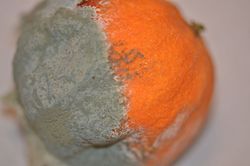| Penicillium italicum | |
|---|---|
 | |
| Scientific classification | |
| Kingdom: | Fungi |
| Division: | Ascomycota |
| Class: | Eurotiomycetes |
| Order: | Eurotiales |
| Family: | Aspergillaceae |
| Genus: | Penicillium |
| Species: | P. italicum |
| Binomial name | |
| Penicillium italicum Wehmer, (1894) | |
Penicillium italicum is a fungal plant pathogen. It is a common post-harvest disease commonly associated with citrus fruits.